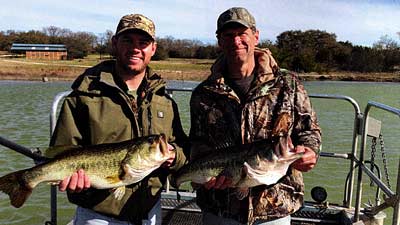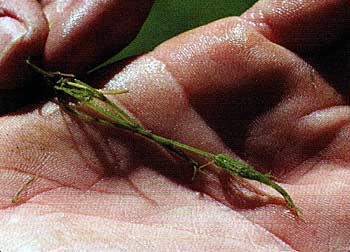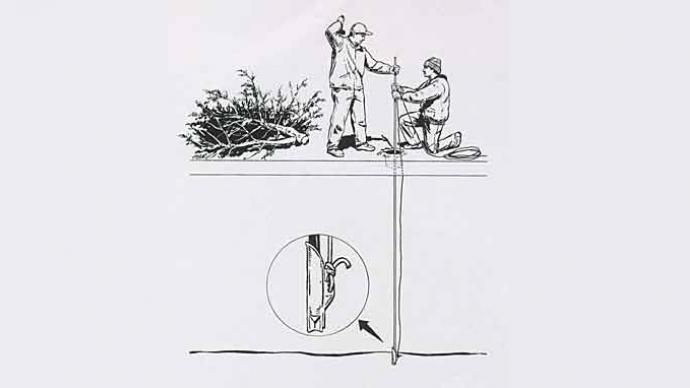
Want to help solve a little biological puzzle?
Walk through the clues with me. In March, we analyzed a small lake in central Texas. The excited family bought this ranch just more than a year ago. They're avid hunters, love to fish, and decided it was time to buy their own place rather than enjoy hunting leases as they have in the past.
It would be a great investment for family and friends.
A focal point on the 500+-acre property is a scenic, mature lake slightly smaller than five acres. Mature means it has some age, is surrounded by mature terrestrial growth and looks like it's been there for several decades, which it has.
Mature also means its fishery has become a reflection of what the lake has to offer. Remember this clue as we work through this story. This part of central Texas has been blessed with bountiful rains over the last year, and this little jewel has benefitted. Water was flowing through a three-foot culvert and clarity was fairly high, as was the water level. Beavers did what beavers do, trying to stop water from flowing. They'd packed some mud and bark-stripped sticks in a tidy little arc about six or seven feet away from the overflow pipe, inside the lake. The lake was several inches above its normal full pool, due to these enterprising buck-toothed workers. While the surface of the lake is shaped similar to Aladdin's Lamp, we figured out the lake bottom is shaped quite different. Using our side-scan sonar, we mapped the lake bottom to find it looked more like a fat-headed bullfrog tadpole, with its tail curved sideways. More than 20% of that lake was less than three feet deep, but when it went deep, it went deep fast. A half-moon shaped flat gently slopes to a sharp-drop creek bed, with a cliff-like rise coming out of the water on the south side shore, layered with limestone top to bottom. We found some water 23 feet deep, coming around to the spout of the lamp-shape.
Water temperature was in the mid-50s, rising from a recent cold snap.
We fired up the electrofishing boat, hoping to find some bass staging pre-spawn. For the first hundred yards, not one fish. Nada. No baby bluegills hiding in flooded grasses along the dam. No bass. We zigzagged parallel along the dam from deep to shallow, and then perpendicular to the dam. Not one fish. We circled the little beaver mud dam, and then stuck the electrodes in shallow grasses as the dam yielded to the shoreline. Nothing there—which isn't normal. As we curved west, along the northern shore, we were in water 3-4 feet deep, flooding buttonbush and small willow trees. Finally, we hit two big female bass paired with a two-plus pound, skinny male. They were doing their spawning dance, and we interrupted them in two feet of water, next to a spread-out, naked buttonbush. The females weighed 7.3 and 8.2 pounds, and the boy was 2.5 pounds, big for his age, but he should have weighed almost 3.25 at 18 inches length. They had all the deep-green mottled markings and
body shape of Florida bass.
We collected the threesome, introduced them to our spacious live well, and moved on. In 45 minutes of on-the-pedal electrofishing, we gathered a total of 12 bass. That's a catch per unit of effort (CPUE) of 16 bass per hour. That's not many bass, folks. For comparison, when we manage for trophy bass, we want at least 30 bass per hour. For balanced lakes, we shoot for 45- 65 bass per hour CPUE. Overcrowded bass can be from 90-200 bass per hour of electrofishing. That's another clue.
For a lake with so few bass, their body condition wasn't as you'd expect. Relative weights were 85-90. That means the were slightly below standard weights for their respective lengths. They weren't unhealthy, just a bit underweight. Usually, in a lake with low numbers of bass, fish tend to be overweight. Not these.
How can that be?
We captured a grand total of four adult bluegills, coppernose bluegills to be exact. The two biggest were 9-10 inches with two more in the 8-inch range. We collected no more than a hundred small bluegills. We also gathered one adult redear sunfish and two redear babies, around three inches each.

We also made some observations about the habitat. In the upper reaches of the lake, we saw several large patches of Chara, a multi-cellular alga. That's a preferred plant in central Texas. Chara, also called Skunkgrass or Muskgrass, gets a bad rap, in my humble opinion. It grows along the lake bottom, but is rarely taller than twelve inches off the bottom. It's dense, almost like ground cover. Other plants have a hard time competing with it. The bad rap comes when a pond or lake level drops, and exposes this plant at the surface. People think it's a nuisance, because they can see it. There were some sprigs of bushy pondweed too, scattered in open spots of the Chara. We told the owners to expect that plant to spread. The flooded shallows were perfect zones for small fish to hide and thrive, and water visibility was around two feet. But we didn't see enough small fish. Usually, with low numbers of bass, we'd see big numbers of small fish.
They'd had a heavy storm two days earlier, adding slightly to turbidity, but clarity was still beyond thirty inches. Another thing struck me as a little bit odd. It's not normal to see so many young willow trees and buttonbush plants in water two to three feet deep. That's a clue this lake is currently at least two feet higher than its normal pool level.
When we finished our preliminary analysis, we had some questions for the new owners.
Here's our basic list:
- How much did the lake level drop last summer?
- What are your angler catch rates?
- How clear was the water last summer?
Their answers provided more clues. The lake dropped about three feet from where it is now, exposing the shallow areas where we saw the brushy, flooded terrestrial growth. That means very little shallow water exists through the summer, until fall rains recharge surrounding seep springs and water runs off the land. Angler catch rates varied, but rarely do they catch more than 10-15 bass per outing. The water was clear down to at least six feet last summer.
So, there's the story.
What would you tell them to do?
For goals, they want higher catch rates. On a good morning or afternoon of fishing, they'd love to catch 25 bass, with three or four of them in the three to five-pound size range, and they'd like a good chance to catch larger fish from time to time. They'd also love to have some huge bluegills, since fly fishing is intriguing to them as well.
You get to be the biologist for this one.
First, the biggest conundrum seems to be such a low fish population. Just stock more fish, right?
What's the true problem for this lake?
Carrying capacity is obviously low, or we'd have seen some abundance of some size class of some species.
Why is that?
Is the lake the problem ?
Are the fish the problem?
Is the water the problem?
Was there some event that caused such a low number of fish? A flood, a drought, a fish kill? Not that we could figure out.
To solve this sort of dilemma, lean on one of the absolute truths about lakes and ponds. I love it when a biologist says, "It's all about the fish."
Believe me, I hear that often. Not true. The truth is that the fish are a reflection of their environment. They can only thrive if they have what they need. They need habitat. They need food. They need happy water. When an organism has all that in detail, they thrive. They thrive as individuals, but better yet, when all those pieces of the biological puzzle come together, the whole population thrives.
Have you solved this dilemma yet?
Water clarity is a big clue. Clear water is sterile when it comes to fish production. Remember this, when baby fish are first hatched, their mouths are tiny. Most species, especially bass and bluegill, glean their food from the water column. They feed on microscopic plankton, primarily tiny insects. If they don't have food, they quickly die. When a fish is first hatched, it has no stores of body fat, so if they don't eat, they don't live long. Fertile water provides the base of the food chain when newly hatched fry needs it the most. If visibility is thirty inches or less in the spring, that's a good sign there's food for babies. If water is too clear at the wrong time, survival rates of new spawns can be abysmal.
Remember, it takes ten pounds of food at each trophic level for organisms to gain a pound. In other words, it takes a hundred pounds of tiny bugs to grow ten pounds of baitfish to grow one pound of bass. Fertile water plays a key role in carrying capacity, and in the standing crop of fish. Clear water plays a role, too. Clear water leads to lower standing crops of fish.
That's what we see in this case.
Another factor is this lake level will drop. That completely changes the complexion of habitat. We recommended a bathymetry map so the owners can create a habitat improvement plan for the lake when it's at its normal state—several feet lower than the day we were there.
Yes, we recommended stocking some fish. With the lake as it is, it's probably at about 30% of its carrying capacity. So, we recommended stocking some fingerling and adult bluegills, and some F1 "Tiger" bass to build up the numbers of fish. We also recommended adding threadfin shad and tilapia to rebuild the food chain over a short period of time.
But stocking fish isn't the answer, unless we take action to increase the productivity of the lake. It could make sense to fertilize this lake, but its alkalinity is quite high, in excess of 200 parts per million calcium carbonates, lime. Pond fertilizer, as soon as it hits the water, will turn cloudy white, and phosphorus will precipitate and fall to the bottom. Since the family is only there one or two weekends per month, they can't monitor a bloom.
That means the best answer is to feed the fish. We recommended a fairly aggressive feeding program, with a focus on feeding a high protein, fish-meal based fish food, and small pellets for bluegills to eat. That feed is converted well, and with a consistent feeding program, our experience suggests the lake's overall productivity will rise as more fish grow and reproduce.
In this case, the problem is the lake's inability to produce many fish due to crystal clear water and minimal habitat during critical times of the year, when fish are reproducing. Over several years, the food chain declined to a point it can't support itself in that water. The bass followed suit. My best guess is that there's 100-150 bass in that lake, and 8-10 of those fish are 7 pounds, plus. Those big fish eat small bass, keeping them from overpopulating the lake.
By replenishing and diversifying the food chain, adding missing year classes of bass, and providing a consistent source of food, this lake will respond quickly.
We expect the goals to be met by next fall.
What were your conclusions? Different recommendations? Email them to me at boblusk@ outlook.com and I'll use them in Ask the Boss next issue. That will be fun.
Reprinted with permission from Pond Boss Magazine



